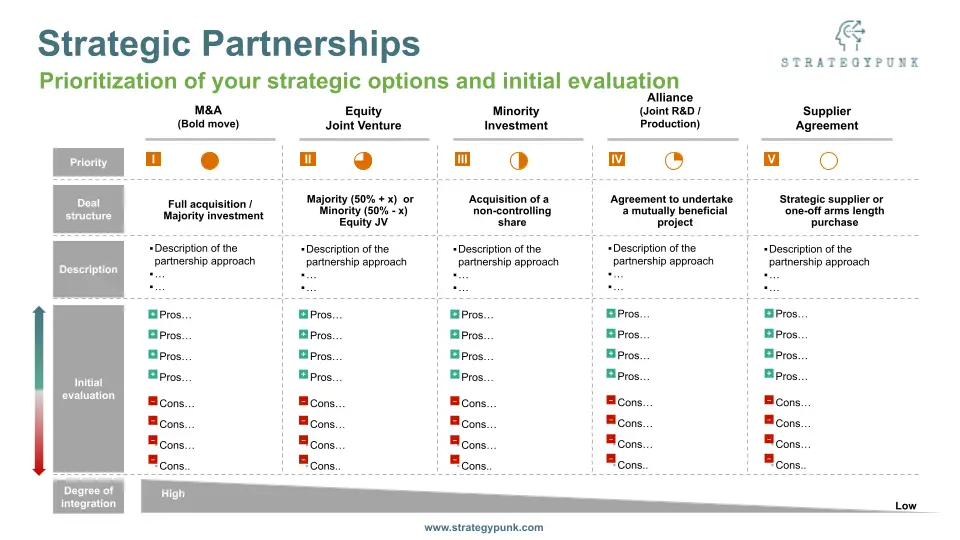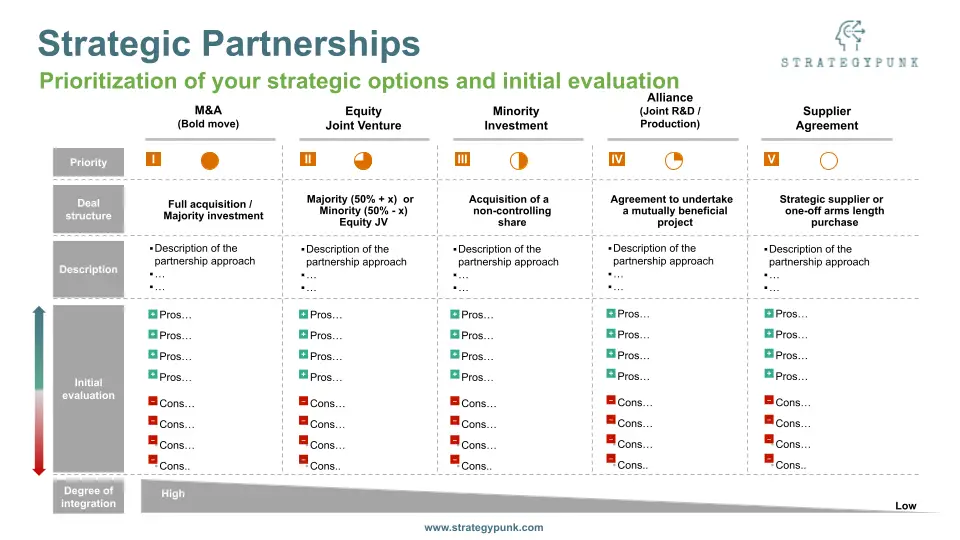Strategic Partnerships: PowerPoint Evaluation Tool
Elevate your strategic partnership options with our guide and free PowerPoint template. Showcase goals, benefits, and plans with ease. Download now!

Welcome to strategic partnerships, b forces to unlock new opportunities, fuel growth, and achieve shared goals.
In today's rapidly changing business landscape, strategic partnerships have become essential for companies looking to expand their reach, tap into new markets, and drive innovation.
This dynamic collaboration enables organizations to leverage each other's strengths and resources, creating a synergistic relationship that benefits all parties involved.
As you embark on this exciting journey, our resources and insights will guide you in forging solid and successful partnerships that create lasting value for your business and partners.
Strategic Partnerships PowerPoint Template
M&A initiatives and s scale, extend reach, and access new technologies, capabilities, or markets. They are a vital part of a company’s growth strategy.

What is a strategic partnership?
A strategic partnership is a mutually beneficial relationship between two or more organizations collaborating to achieve shared objectives, leveraging each other's strengths and resources.
How do we create a successful strategic partnership?
To create a successful strategic partnership, identify complementary goals, establish clear communication, define expectations and roles, and build trust through transparency and mutual commitment.
What are the benefits of strategic partnerships?
Benefits of strategic partnerships include access to new markets, shared resources, increased innovation, risk mitigation, and accelerated growth.
How do we identify potential strategic partners?
To identify potential strategic partners, look for organizations with complementary skills, values, and goals, as well as those that can offer resources or expertise that your organization lacks.
What are the key elements of a strategic partnership agreement?
Critical elements of a strategic partnership agreement include a clear outline of objectives, roles and responsibilities, resource allocation, communication protocols, conflict resolution methods, and performance metrics.
How do you manage and maintain a strategic partnership?
To manage and maintain a strategic partnership, ensure open communication, regularly review progress and goals, address challenges proactively, and invest in relationship-building activities.
What are the common challenges faced in strategic partnerships?
Common challenges in strategic partnerships include misaligned objectives, communication breakdowns, cultural differences, and lack of trust or commitment.
How is the success of a strategic partnership?
To measure the success of a strategic partnership, monitor key performance indicators (KPIs) that align with your shared objectives, such as revenue growth, market expansion, or innovation metrics.
What are some examples of successful strategic partnerships?
Examples of successful strategic partnerships include Google and NASA, Starbucks and Spotify, and BMW and Toyota, which showcase how collaboration can drive innovation, market expansion, and brand enhancement.
How do strategic partnerships differ from other types of partnerships?
Strategic partnerships focus on long-term, mutually beneficial collaborations with shared objectives rather than purely transactional or short-term relationships.
What are the types of strategic partnerships?
Strategic partnerships come in various forms, each designed to help organizations achieve specific goals by leveraging their partners' strengths. Understanding the different types of strategic alliances can help you determine the best fit for your organization's needs.
Let's explore some common types of strategic partnerships and how they can provide value to all parties involved.
- Joint Ventures: In a joint venture, two or more companies create a separate legal entity to pursue a shared business objective. This new entity often combines the partnering organizations' resources, expertise, and technologies. Joint ventures can be an excellent way to access new markets, share risks, and pool r while maintaining a distinct identity for each participating company. A well-known example is Sony Ericsson, a joint venture between Sony Corporation and Ericsson that focused on producing mobile phones.
- Co-Marketing Partnerships: Co-marketing partnerships involve companies working together to promote each other's products or services. By leveraging each other's the customer base and marketing channels, co-marketing partners can reach new audiences and generate more significant exposure. For instance, Spotify and Starbucks partnered to create unique in-store playlists, combining Starbucks' physical retail presence with Spotify's digital music platform.
- Distribution Partnerships: Distribution partnerships enable companies to expand their market reach by utilizing the partner's established distribution channels. This can be particularly beneficial when entering new markets or industries where a company needs more experience or resources. For example, Netflix partnered with Comcast to make its streaming service available on Comcast's Xfinity X1 platform, allowing Netflix to reach a broader audience.
- Product Integration Partnerships: In product integration partnerships, companies collaborate to integrate their products or services, creating a more comprehensive and seamless user experience. This partnership can drive innovation and improve customer satisfaction by combining complementary features and capabilities. An example is Apple integrating Google Maps into the iPhone, which allowed users to access both companies' services in a unified way.
- Technology Licensing Partnerships: Technology licensing partnerships involve one company granting another the rights to use its intellectual property, such as patents or software, in exchange for royalties or other compensation. This type of partnership can help companies monetize their innovations while providing partners with access to cutting-edge technology. For instance, ARM Holdings licenses its microprocessor designs to various tech companies, such as Apple and Samsung, which then use these designs in their devices.
- Research and Development (R&D) Partnerships: R&D partnerships involve organizations working together to develop new products, services, or technologies. These partnerships can pool resources and expertise, reduce R&D costs, and accelerate innovation. An example is the collaboration between BMW and Toyota to develop fuel cell technology for vehicles, combining their engineering know-how to create more sustainable transportation solutions.
In conclusion, strategic partnerships come in various forms, each with unique benefits and challenges. By understanding the different types of strategic partnerships and evaluating your organization's needs, you can forge valuable collaborations that drive growth, innovation, and long-term success.
The different t p ships in the PowerPoint Evaluation tool:
Strategic Partnerships typically cover the following deal spectrum:
- M&A: a full acquisition, merger, or majority investment
- Equity Joint Venture: Majority (50% + X) or Minority (50%-X) Equity JV
- Minority Investment: Acquisition of a non-controlling stake in a company
- Alliances: typical a joint R&D, Production or even Co-Marketing cooperation
- Supplier Agreement - from a strategic supplier relationship to a one-time purchase at arm’s length principle
Strategic Partnerships: Free PowerPoint Evaluation Tool
The ability to form strategic and sustainable partnerships is a critical competitive advantage in today's highly competitive market environment.
Knowing your options with all the pros and cons is an essential first step before deep diving into specific options.
Strategic Partnerships Google Slides Template
Strategic Partnerships Evaluation Tool Google Slidesarms-length






